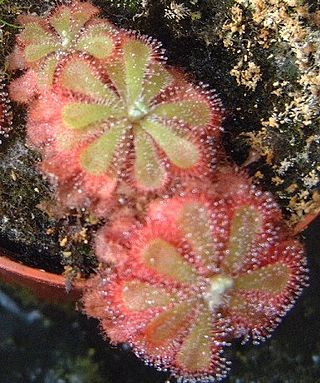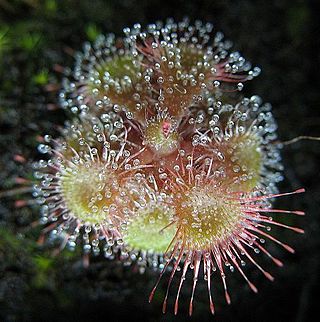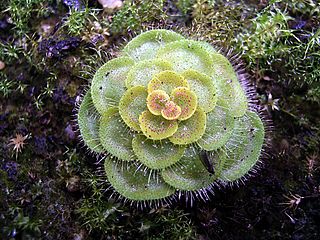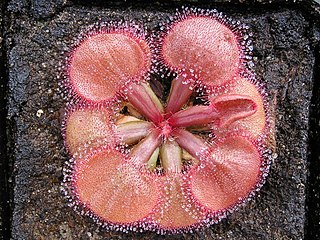
Drosera, which is commonly known as the sundews, is one of the largest genera of carnivorous plants, with at least 194 species. These members of the family Droseraceae lure, capture, and digest insects using stalked mucilaginous glands covering their leaf surfaces. The insects are used to supplement the poor mineral nutrition of the soil in which the plants grow. Various species, which vary greatly in size and form, are native to every continent except Antarctica.

Drosera aliciae, the Alice sundew, is a carnivorous plant in the family Droseraceae. It is native to the Cape Provinces of South Africa, like Drosera capensis, the cape sundew, and is one of the most common sundews in cultivation. The plant forms small, tight rosettes of wedge-shaped leaves, up to 5 cm in diameter. Under conditions of good lighting, the insect-snagging tentacles will become deeply coloured with anthocyanin pigments, which probably aid in its attraction of insect prey. The plant is relatively easy to grow, and produces attractive scapes of pink flowers, which are held about 30 cm away from the carnivorous leaves, so as to prevent pollinators from becoming ensnared. D. aliciae is very similar in form to a number of other closely related species such as D. slackii, and D. natalensis: the former is rather larger with a slightly different growth habit(8 cm diameter); the latter has hairier stipules and a larger distance between leaf base and the “sticky” trichomes.

Drosera capensis, commonly known as the Cape sundew, is a small rosette-forming carnivorous species of perennial sundew native to the Cape in South Africa. Because of its size, easy-to-grow nature, and the copious amounts of seed it produces, it has become one of the most common sundews in cultivation, and thus, one of the most frequently introduced and naturalised invasive Drosera species.

Drosera peltata, commonly called the shield sundew or pale sundew, is a climbing or scrambling perennial tuberous species in the carnivorous plant genus Drosera. Among the tuberous sundews, D. peltata has the largest distribution, which includes eastern and western Australia, New Zealand, India, and most of Southeast Asia including the Philippines. The specific epithet is Latin for "shield shaped", a reference to the shape of the cauline leaves. It is either a single extremely variable species, or a complex of several closely related species of uncertain taxonomic boundaries. In Australia at least four forms have had or still have specific taxonomic recognition: Drosera peltata subsp. peltata, D. peltata subsp. auriculata, D. foliosa and D. gracilis.

Drosera adelae, commonly known as the lance-leaved sundew, is a carnivorous plant in the genus Drosera that is endemic to Queensland, Australia.

Drosera binata, commonly known as the forked sundew or fork-leaved sundew. It is a large, perennial sundew native to Australia and New Zealand. The specific epithet is Latin for "having pairs" - a reference to the leaves, which are dichotomously divided or forked.

Drosera banksii, commonly known as Banks' sundew, is a small annual species in the carnivorous plant genus Drosera. The reniform-shaped leaves are attached to petioles and arranged in a circular pattern (rosette) around the stem. The 5 mm wide flowers are white. It is native to northern Australia and Southeast Asia. D. banksii was originally described by Robert Brown and validly published by Augustin Pyramus de Candolle in 1824. It is currently classified in the subgenus Lasiocephala, but expert opinion is that it is misplaced and should be reclassified with the closely allied D. subtilis.

Drosera burmanni, the tropical sundew, is a small, compact species in the carnivorous plant genus Drosera. Its natural geographical range includes the tropical and subtropical regions of Asia, Australia, India, Japan, southeast Asia, Oceania, Africa and China's Guangxi, Guangdong, Yunnan, Fujian, Taiwan. It normally spans only 2 cm (0.8 in) in diameter. It is one of the fastest trapping sundews as well, and its leaves can curl around an insect in only a few seconds, compared to the minutes or hours it takes other sundews to surround their prey. In nature, D. burmanni is an annual, but in cultivation, when grown indoors during the cold months, it can live for many years. Since D. burmanni is an annual, it produces large amounts of seed. Drosera burmanni has been considered a powerful rubefacient in Ayurveda.

Drosera erythrorhiza, the red ink sundew, is a perennial tuberous species in the carnivorous plant genus Drosera that is endemic to Western Australia. It grows in a rosette and is distinguished from the other species in section Erythrorhiza by its many-flowered cymose inflorescences with up to 50 individual flowers. D. erythrorhiza was first described by John Lindley in his 1839 publication A sketch of the vegetation of the Swan River Colony. In 1992, N. G. Marchant and Allen Lowrie described three new subspecies, thus also creating the autonym D. erythrorhiza subsp. erythrorhiza. The subspecies were separated from this variable species mostly by leaf morphology and distribution.

Drosera zonaria, the painted sundew, is a perennial tuberous species in the carnivorous plant genus Drosera and is endemic to south-west Western Australia from near Perth southeast to near Esperance. It grows in a tight rosette approximately 5 to 7 cm in diameter with 20 to 30 green to red leaves that are arranged in concentric layers. The leaves are typically 1 cm wide and are usually described as being "kidney-shaped" with crimson leaf margins. It grows in deep silica sands in open woodland or coastal heathland and only flowers after a bush fire, which is speculated to be caused by the release of ethylene. Its white, sweetly perfumed flowers, which are very similar to those of D. erythrorhiza, emerge on 4 to 5 cm tall scapes. As with most other tuberous Drosera species, D. zonaria will die back during the dry summer months and retreat to the fleshy tuber 10 to 30 cm below ground.

Drosera slackii is a subtropical sundew native to the Cape Provinces of South Africa. It forms rosettes that range from to two to four inches in diameter, and produces pink flowers. It is named after the British plantsman and author Adrian Slack (1933-2018).

Drosera andersoniana, the sturdy sundew, is an erect perennial tuberous species in the genus Drosera that is endemic to Western Australia. It produces a basal rosette of leaves similar to that of D. peltata and the stem grows to 8–25 cm (3–10 in). Its pink-white to red flowers emerge from August to September. D. andersoniana grows in loamy soils near granite outcrops.

Drosera gigantea, the giant sundew, is an erect perennial tuberous species in the carnivorous plant genus Drosera that is endemic to Western Australia. It grows in sandy soils at the margins of swamps and near granite outcrops along the Western Australian coast from Albany north to just south of Geraldton. D. gigantea produces small shield-shaped leaves along many lateral branches that look like a small tree. Individual plants can grow up to 0.2–1 m (0.7–3.3 ft) tall. Because of its tall, tree-like form, it is considered one of the largest Drosera species. It is also easily cultivated and enjoys damp, humid conditions often provided in greenhouses. White flowers emerge from August to November. The red tubers of this species can grow to be 3.8 cm (1.5 in) in diameter and may be a metre below ground.

Drosera microphylla, the golden rainbow, is an erect perennial tuberous species in the carnivorous plant genus Drosera. It is endemic to Western Australia and grows on granite outcrops or in sandy or laterite soils. D. microphylla produces small, circular, peltate carnivorous leaves along erect stems that can be 10–40 cm (4–16 in) high. It blooms from June to September, displaying its large golden sepals and smaller, variably-coloured petals. In populations near Perth, the petals are red, whereas petal colour near Albany tends to be orange. Some plants east of Esperance have white petals.

Drosera glanduligera, commonly known as the pimpernel sundew or scarlet sundew, is a species of carnivorous plant endemic to southern Australia. It is an ephemeral annual plant that grows in the winter and flowers from August to November.

Drosera meristocaulis is a perennial species in the carnivorous plant genus Drosera, the only member of the subgenus Meristocaulis. It is a small, rosette- and branched stem-forming sundew that has many morphological affinities to the Australian pygmy sundews. D. meristocaulis is wholly endemic to Pico da Neblina, an isolated mountain on the Brazil-Venezuela border.

Drosera falconeri is a carnivorous plant in the family of Droseraceae. It is endemic to the Northern Territory of Australia.
Drosera viridis is a semi-erect or rosetted perennial species in the carnivorous plant genus Drosera. It is known only from Brazil, being found in eastern Paraná and São Paulo and central Santa Catarina at elevations from 550–1,100 m (1,800–3,610 ft). It may, however, also be found in adjacent Argentina, Paraguay, and Uruguay. It typically grows in waterlogged habitats among grasses in white-clayey, reddish lateritic, or humus-rich black-brown soils and is sometimes found submerged with only the leaves above water.
Drosera peruensis is a carnivorous plant of the genus Drosera, commonly known as the Peruvian sundew. This Drosera species was first identified in Peru in 2002 by Tânia Regina dos Santos Silva and Mireya D. Correa following work to update the genus Drosera for the reference text, Flora Neotropica..

Drosera hookeri, the grassland sundew is an shortly erect perennial tuberous species in the carnivorous plant genus Drosera. Drosera hookeri is found in south-eastern Australia. Although the holotype was collected in Tasmania, its distribution also includes Victoria, New South Wales and South Australia. This species has a complex taxonomic history, and its specific epithet acknowledges the original recognition of the taxon by Joseph Dalton Hooker. Hooker originally called his species Drosera foliosa Hook.f. ex Planch. in 1848, a name that was illegitimate as it had previously been used to describe a different species. The nomenclature of D. hookeri was later clarified and the taxonomic concept significantly broadened to include most of the south-eastern Australian and New Zealand forms of the species complex that includes Drosera peltata.




















